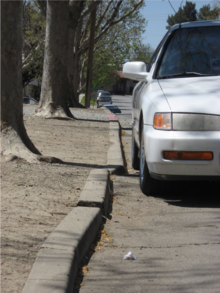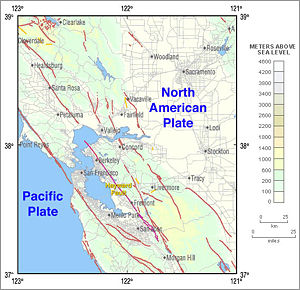Calaveras Fault
[1] It runs east of the San Andreas, diverging from it in the vicinity of Hollister, California, and is responsible for the formation of the Calaveras Valley there.Stresses are also produced by offset and converging slip-strike motions between the Calaveras and Clayton-Marsh Creek-Greenville Fault that continue to elevate Mount Diablo.The compressive pressure is manifest in a significant thrust fault nearby on the western slope of the mountain, the Mount Diablo Thrust Fault,[3] the most active of its kind in the region and which is also capable of producing significant local earthquakes affecting the Alamo-Danville area.In California, the plate is sliding northwestward along a transform boundary, the San Andreas Fault, toward the subduction zone.Assessments in January 2008 suggest that the northern Calaveras fault (the portion between Sunol and Danville) may be more likely to fail in the next few decades than previously thought.


Calaveras (disambiguation)San Andreas FaultCaliforniaSan Francisco Bay Areaaseismic creep1984 Morgan Hill event2007 Alum Rock eventWest Napa FaultDanvilleSan RamonDublinPleasantonMilpitasSan JoseGilroyHollisterGeologic mapHollister, CaliforniaCalaveras ValleyHayward FaultSan Jose, CaliforniaClayton-Marsh Creek-Greenville FaultfaultslatitudeSan FranciscoCalaveras CreekSanta Clara Countya California countySierra NevadaNapa CountyCarquinez StraitConcord FaultAlamo, CaliforniaMount Diablothrust faultMount Diablo Thrust FaultPacific plateEast Pacific RiseAleutian TrenchNorth American plate2007 (5.6)1984 (6.2)Morgan HillMorgan Hill in 1984magnitude 5.6 earthquakeAlum Rock2014 South Napa earthquakeLoma Prieta earthquakeLick ObservatoryBernal SubbasinTesla FaultBibcodeSouthern California Earthquake CenterSeismically activefault zonestectonic blocksSalinian BlockSouthern CaliforniaBrawley Seismic ZoneChino FaultElsinore Fault ZoneElysian Park FaultGarlock FaultHollywood faultHosgri FaultImperial Fault ZoneLaguna Salada FaultNewport–Inglewood FaultNorthridge Blind Thrust FaultPeninsular RangesPuente Hills FaultRaymond FaultRose Canyon FaultSalton TroughSan Cayetano FaultSan Diego Trough Fault ZoneSan Felipe Fault ZoneSan Gabriel FaultSan Jacinto Fault ZoneSanta Maria River FaultSanta Ynez FaultShoreline FaultSierra Madre Fault ZoneVentura FaultWhite Wolf FaultWhittier FaultYorba Linda FaultNorthern CaliforniaHayward Fault ZoneHealdsburg FaultMaacama FaultMendocino fracture zoneMendocino triple junctionMonta Vista FaultPleasanton FaultSan Gregorio FaultSan Pablo FaultSeal Cove FaultSerra FaultSilver Creek FaultDeath Valley Fault ZoneFurnace Creek Fault ZoneHoney Lake Fault ZoneKern Canyon FaultMaria fold and thrust beltRescue Lineament-Bear Mountains fault zoneSierra Nevada BatholithSierra Nevada FaultSierra Nevada–Great Valley BlockSmartville BlockWalker LaneCalifornia Geological SurveySeismic Hazards Mapping ActMexico (list)Basin and Range ProvinceCanadian Arctic Rift SystemCascadia subduction zoneClarendon-Linden fault systemDenali FaultNorthern Cordilleran Volcanic ProvincePuget Sound faultsRio Grande riftSouthern Great Lakes seismic zoneTintina FaultCharlevoix seismic zoneLaurentian Slope seismic zone